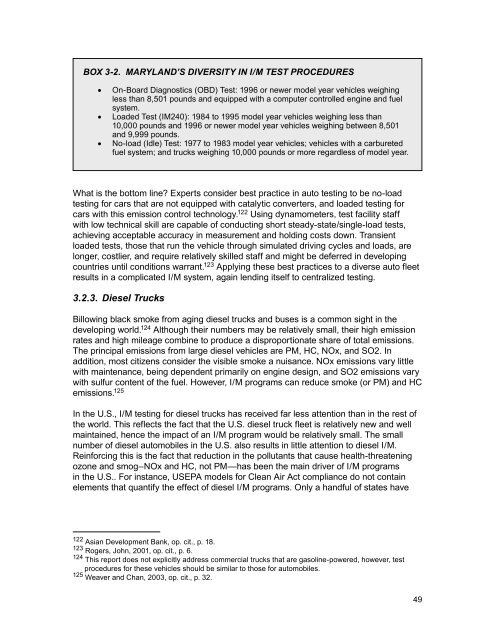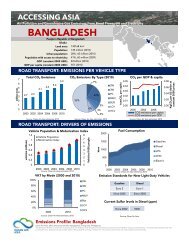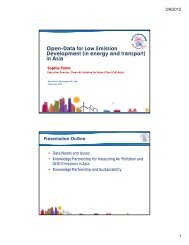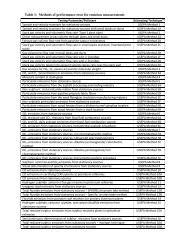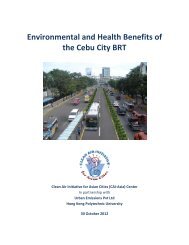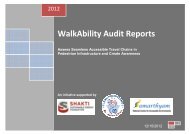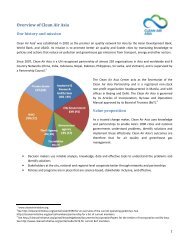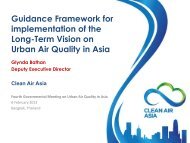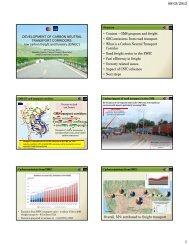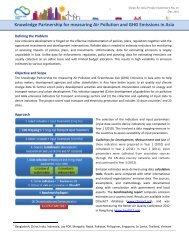International Experience and Best Practices - Clean Air Initiative
International Experience and Best Practices - Clean Air Initiative
International Experience and Best Practices - Clean Air Initiative
Create successful ePaper yourself
Turn your PDF publications into a flip-book with our unique Google optimized e-Paper software.
BOX 3-2. MARYLAND’S DIVERSITY IN I/M TEST PROCEDURES<br />
• On-Board Diagnostics (OBD) Test: 1996 or newer model year vehicles weighing<br />
less than 8,501 pounds <strong>and</strong> equipped with a computer controlled engine <strong>and</strong> fuel<br />
system.<br />
• Loaded Test (IM240): 1984 to 1995 model year vehicles weighing less than<br />
10,000 pounds <strong>and</strong> 1996 or newer model year vehicles weighing between 8,501<br />
<strong>and</strong> 9,999 pounds.<br />
• No-load (Idle) Test: 1977 to 1983 model year vehicles; vehicles with a carbureted<br />
fuel system; <strong>and</strong> trucks weighing 10,000 pounds or more regardless of model year.<br />
What is the bottom line? Experts consider best practice in auto testing to be no-load<br />
testing for cars that are not equipped with catalytic converters, <strong>and</strong> loaded testing for<br />
cars with this emission control technology. 122 Using dynamometers, test facility staff<br />
with low technical skill are capable of conducting short steady-state/single-load tests,<br />
achieving acceptable accuracy in measurement <strong>and</strong> holding costs down. Transient<br />
loaded tests, those that run the vehicle through simulated driving cycles <strong>and</strong> loads, are<br />
longer, costlier, <strong>and</strong> require relatively skilled staff <strong>and</strong> might be deferred in developing<br />
countries until conditions warrant. 123 Applying these best practices to a diverse auto fleet<br />
results in a complicated I/M system, again lending itself to centralized testing.<br />
3.2.3. Diesel Trucks<br />
Billowing black smoke from aging diesel trucks <strong>and</strong> buses is a common sight in the<br />
developing world. 124 Although their numbers may be relatively small, their high emission<br />
rates <strong>and</strong> high mileage combine to produce a disproportionate share of total emissions.<br />
The principal emissions from large diesel vehicles are PM, HC, NOx, <strong>and</strong> SO2. In<br />
addition, most citizens consider the visible smoke a nuisance. NOx emissions vary little<br />
with maintenance, being dependent primarily on engine design, <strong>and</strong> SO2 emissions vary<br />
with sulfur content of the fuel. However, I/M programs can reduce smoke (or PM) <strong>and</strong> HC<br />
emissions. 125<br />
In the U.S., I/M testing for diesel trucks has received far less attention than in the rest of<br />
the world. This reflects the fact that the U.S. diesel truck fleet is relatively new <strong>and</strong> well<br />
maintained, hence the impact of an I/M program would be relatively small. The small<br />
number of diesel automobiles in the U.S. also results in little attention to diesel I/M.<br />
Reinforcing this is the fact that reduction in the pollutants that cause health-threatening<br />
ozone <strong>and</strong> smog–NOx <strong>and</strong> HC, not PM—has been the main driver of I/M programs<br />
in the U.S.. For instance, USEPA models for <strong>Clean</strong> <strong>Air</strong> Act compliance do not contain<br />
elements that quantify the effect of diesel I/M programs. Only a h<strong>and</strong>ful of states have<br />
122 Asian Development Bank, op. cit., p. 18.<br />
123 Rogers, John, 2001, op. cit., p. 6.<br />
124 This report does not explicitly address commercial trucks that are gasoline-powered, however, test<br />
procedures for these vehicles should be similar to those for automobiles.<br />
125 Weaver <strong>and</strong> Chan, 2003, op. cit., p. 32.<br />
49


